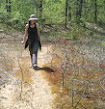 "Local Invasion: The Garlic Mustard plant is an invasive species that inhibits the growth of native plants. The best time to remove the plant is in the Spring prior to its seed development in June. Composting is not recommended, as the seeds remain viable for up to 5 years."
"Local Invasion: The Garlic Mustard plant is an invasive species that inhibits the growth of native plants. The best time to remove the plant is in the Spring prior to its seed development in June. Composting is not recommended, as the seeds remain viable for up to 5 years."
- An example of a quick fact that can be added to a newsletter.
I just saw Vermont's "WOW" Wise on Weeds & "Recognize. Remove. Replant." invasive plant species public education program for the first time today.
And now I want to see similar invasive plant species public outreach / education awareness in
I especially liked their "Invasive Exotic Plant Fact Sheet Series "
I've been thinking about Vermont's 3 R's... and now I notice that I'm going a few steps further when I'm confronting an invaded area:1. Recognize: ID the species and read about what they do (which species and habitats and ecological functions they degrade and displace) and how they do it (including how the species is spread and its reproductive biology). Also ID existing native and invasive plants in the area.
2. Remove: look-up and use established "removal protocols" and tools for specific species.
My favourite way to find removal protocols is by looking up its ESA (Element Stewardship Abstract) at TNC Weeds. (They also have great links on the left about manual control methods and more!)Concurrently, plan on removing other invasive species in the same area.
3. Dispose: e.g. do not put seeds or roots or reproductive parts of an invasive plant into garden compost.
4. Remediate: in urban areas, remove cultural or post-industrial garbage and gravels from soils; if you have impossibly dense compacted clay and need to improve drainage, dig in horticultural sand (not playground sand, that's a recipe for brick making); add mycorrhizae and bone meal (natives like its natural slow release) as supplements (ask at a larger local nursery) at the time of planting; get off synthetic fertilizers entirely (many just-add-water or "Miracle" N-Ph-P products are salt-based and actually dehydrate your soil biota to death); add 1.5 ->2.5 inches of leaf and bark mulch to soil surfaces to encourage beneficial fungi, and very small amounts of compost to soil surface (native plants can be harmed, burned when compost is added directly to root zone) to encourage beneficial bacteria species. Update: "Teaming with Microbes" – excellent book for learning about your soils, how to remediate them and how to keep them healthy too.
5. Replant: let the area's sun light levels, moisture, soil texture, pH, minimum winter temperature help you decide which native plants (and ideally native plant communities) are suited for the area, and, where possible, look to existing or historic native plant communities in the area for guidance. Our historic plant communities here in Toronto and Southern Ontario include dry-moist prairies and meadows (each full sun), woodland (mostly shade but can include some sun), forest (deeper shade). Replant with common hardy native species (even aggressive colonizers (e.g. obedient plant, big-leaved-aster and ginger in worst invaded areas); plant in seasonal guilds (Steven Murphy writes about this in SER-O's Native Plant Nursery Guide 2007-2008) e.g. in shaded areas: bloodroot, ginger and mayapple in spring -> zig-zag goldenrod in same area come fall). This ongoing coverage will shade invasive seeds from germinating, and populate and use soil resources otherwise vulnerable to being exploited by invasives. Also, in woodland / forest / shade areas plant for all layers: ground cover, herbaceous perennial, shrub, tree.
6. Return: go back to the same area and weed; remove tree guards; learn from the plants that made it, and those that didn't (ask why); replace vacancies created by plants that didn't make it; replace decomposed mulch; water during establishment phase and drought. After plants are well established, try more sensitive / less common natives appropriate to the area, but please avoid really habitat-specific rare species and species-at-risk (e.g. bird's-foot violet, most native orchids, Britton's Moss Phlox, Indian Pipe, Indian Paint Brush and native wild blue lupines have very low survival rates outside of their specific habitats and it's depressing to watch them die quickly or slowly over years in a garden ...while you realize that they shouldn't have even been exploited from their natural habitats.)
7. Prevent: includes prophylactically planting in bare soils; cutting invasive weeds before they go to seed e.g. while in bloom (may be necessary to cut several times during growing season). Public education.
Stewards, gardeners, field naturalists: we're already out there on the land and educating and organizing in our communities,and, although I wish we didn't have to confront it (not to mention the things I'd rather do), we've seen it first hand, we know what's happening and at the very least, we each know a spared place left we can't bare to think of becoming invaded & destroyed.
Public education is something each of us can add even a few minutes attention to, each of us can easily integrate invasive species awareness into our walks & workshops, newsletters, fact sheets, articles, blogs, websites, meetings, events and our groups' agendas.
*
UPDATE:
- The Ontario Federation of Hunters (OFHA) and Anglers has taken the lead. Check out this "invasive plants" section of their Invading Species Awareness Program.
- To stay informed about invasive plant initiatives in Ontario, including the Ontario Invasive Plants Council, keep your eyes on Ontario Stewardship's Invasive Iniatives page.
- Here's a list of invasive plant resources I find useful in our area.


No comments:
Post a Comment